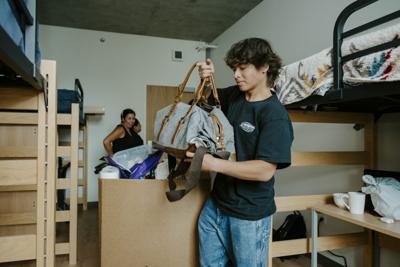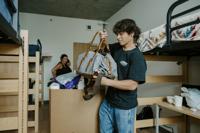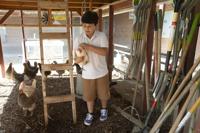
This story was originally published by EdSource. Sign up for their daily newsletter.
Dorm life at Sacramento State University suited Sofia Gonzalez. Living on campus her first year, most classes were a 10-minute walk away. Most of her closest friends lived in the same residence hall. “Everything,” she said, was “right there.”
But this summer, as she prepared to start her sophomore year, friends who applied for university housing warned Gonzalez they had been placed on a wait list. Daunted by the limited supply of upperclassmen dorms — and most of all, the cost of on-campus rent — Gonzalez opted to try the private market instead. “There was nowhere I could live in my price range near campus,” said Gonzalez, a business and marketing major. She contemplated transferring to a community college or commuting two hours each way from her parents’ Bay Area home to Sacramento.
Housing can be a major barrier for low-income students like Gonzalez around the California State University system, which includes Sacramento State and 22 other campuses. Recent estimates have found that housing accounts for half the cost of attendance at CSU, and that 11% of CSU students surveyed experience homelessness or housing insecurity.
That reality is one reason why CSU added more than 17,000 new beds between 2014 and 2024. About 5,600 more are either under construction or approved to be built. The investments in housing are giving CSU a more residential flavor, even as many campuses maintain their long-standing dependence on commuters.
Now the question is whether CSU should build even more housing, especially in hot real estate markets where students struggle to find off-campus alternatives. A systemwide housing plan issued by CSU in July sketches potential projects that could house an additional 12,600 students as soon as 2030.
CSU officials say on-campus housing improves students’ graduation rates and could ease housing pressures for Cal State’s 460,000 students, 87% of whom still live off campus with their families or otherwise. Future housing development could be uneven based on current enrollment trends across the system, which have left empty dorms at a handful of Cal State campuses, while others rework double-occupancy rooms into triples to meet growing demand.
At the same time, state lawmakers are weighing a potentially hefty 2026 bond measure for student housing and other educational facilities at CSU, the University of California and the California Community Colleges system. Supporters say the measure, which has yet to determine a dollar amount, could help make college more affordable for low-income students.
“To make sure students are successful in their learning, they’ve got to be able to have stable housing,” Assemblymember David Alvarez, D-San Diego, who introduced the legislation, said at a hearing on Assembly Bill 48.
At Cal State Northridge, which plans to open a new 198-bed housing complex this fall, 2,000 students were on a waiting list for housing in fall 2024, CSU data show. Kevin Conn, the university’s executive director of student housing and residential life, said his colleagues field regular calls from students desperate for student housing. “Their stories are really, really heart-wrenching, because we can only do so much,” he said. “We can’t just put them in; there’s no spot to put them.”
Sacramento State has faced a similar conundrum. Last fall, there were more than 4,400 students who requested to live in campus housing, but fewer than 3,300 beds were available. The campus plans to house hundreds of additional students in the coming years.
In the meantime, Gonzalez’s frantic housing search ended off campus. She found a room 30 minutes from campus for $800 a month — within her budget, but expensive enough that she will likely need a second job to afford rent and groceries. “It’s going to be hard this next year to manage my money,” she said.
A push into housing at CSU
California State University has a long history of serving predominantly commuter students, though the university system has made major investments in student housing over the past two decades. Federal data show CSU has almost doubled its capacity to house students since 2004.
CSU’s housing program nonetheless continues to trail the University of California system, which today houses 40% of students. That’s more than 120,000 students in UC housing compared to roughly 60,000 across CSU. A majority of students in both systems live off campus.
CSU argues that adding more university housing will boost students’ academic performance. Officials point to evidence from San Diego State University, which found students living on campus had higher graduation rates and grade point averages as well as lower rates of academic probation compared to their off-campus peers. Researchers have documented similar positive effects in other states, too.
Another concern is cost. University officials said they strive to keep student housing affordable relative to peer institutions and nearby market-rate units.
In 2024, the CSU-wide average rate for a two-person unit in a residence hall was $9,668 over an academic year. Cal Poly Humboldt hosted the cheapest doubles, charging $6,624 on average, while San Diego State’s $14,344 average was the system’s most expensive.
If lawmakers and then voters approve a bond measure, housing projects would likely compete with the university system’s substantial deferred maintenance needs. The potential construction boom could also be dampened by a dreary economic outlook for CSU, which faces a $2.3 billion budget gap.
Such financial constraints are top of mind for Kamran Garcia Hosseinzadeh, a recent graduate and resident assistant of Cal State Dominguez Hills. CSUDH plans to add hundreds of additional beds to campus by 2026, but Garcia Hosseinzadeh is skeptical that the university has the capacity and the funding to operate expanded housing. “I definitely don’t feel confident with the future of housing here,” they said.
Declining enrollment at some CSU campuses adds to the financial uncertainty. Systemwide, 92% of student housing is filled, but at shrinking campuses like Sonoma State University and CSU East Bay, where only 64% and 58% of housing, respectively, was occupied in fall 2024.
Another Cal State campus has struggled to recover from a pandemic-era downturn in housing occupancy. Auditors reported that years of operating losses in Cal State L.A.’s housing program are depleting its reserves. Occupancy has dropped to as low as 60% in recent years, auditors said, and student housing required “unanticipated emergency repairs.” Responding to the audit, Cal State L.A.’s director of housing wrote that the university had taken “sweeping corrective measures” to improve campus housing.
University officials at other Cal State campuses said they’re confident there is room to grow on their campuses, despite warnings of an impending decline in traditional college-aged students. Even if student headcount plateaus, they said, housing wait lists and other metrics suggest untapped potential to bring students who are forced to search for off-campus housing into on-campus dorms.
An experiment in San Luis Obispo
With almost 9,000 on-campus beds, Cal Poly San Luis Obispo is the housing heavyweight of the Cal State system. A large majority of the university’s students are from outside county lines, so many of the roughly 14,000 students living off campus spill into residential neighborhoods, where their sheer numbers threaten to drive already expensive rents even higher.
The housing market near the Central Coast campus is so pricey — average rent is 31% higher than the national average, according to Zillow Rentals data — students on a budget sometimes lease less-than-ideal accommodations.
Jordan Schleifer, a recent graduate who led several housing-related initiatives while vice president of Cal Poly Democrats, said many such dwellings lack basic safety fixtures like fire escapes or working smoke detectors. “It creates a situation where students are living in unsafe conditions and they can’t be fixed because they don’t want to lose the housing,” Schleifer said.
And enrollment-wise, San Luis Obispo’s master plan projects that the student headcount will increase from 22,400 in fall 2024 to 25,000 by 2035.
Financial limitations have forced San Luis Obispo’s leaders to get creative. Eager to save on construction costs — and to avoid passing those costs onto students — the university has converted some double-occupancy dorms into triples.
But the university’s most ambitious experiment is just starting. Next fall, the university will install the first in a series of modular, factory-built housing units, aiming to add as many as 4,000 beds over several years. Housing modules will get trucked to campus and then “stacked on top of each other like Legos,” said Mike McCormick, the university’s vice president of facilities management and development.
The hope is that as the factory starts producing modules at scale, the cost to produce each one will drop below traditional on-site construction. “We’re a long way from having this be a really efficient process yet, but you have to start somewhere,” McCormick said.
Lawmakers weigh student housing policy
Reports of college students living in their cars and surveys revealing the scale of student homelessness have prompted state lawmakers to take a more aggressive approach to student housing in recent years.
Typically, CSU finances housing by issuing bonds. But California lawmakers took a more active role in 2021 when they established a $2.2 billion grant program to help fund housing across CSU, UC and community colleges.
A dozen projects at CSU have been named grant recipients to date. Altogether, the projects are expected to add 5,000 beds to campuses from Cal Poly Humboldt to San Diego State. The grants provided about $660 million, which was nearly half the cost of 12 CSU projects, while the system provided the rest.
Some of that housing is now open to students. That includes a 729-bed project at San Francisco State University and San José State University’s Spartan Village on the Paseo, which converted an existing hotel into student housing.
Now that the state grant funding has been awarded, advocates, including the Student Homes Coalition, have turned their attention to a bill aimed at spurring more off-campus housing by creating “campus development zones,” where the review process for housing development projects would be streamlined.
The other option, the state facilities bond AB 48, passed the Assembly and is currently in the Senate. Details, including a dollar figure, would be finalized in spring 2026 in hopes of putting the bond on the November ballot.
“The decision to send someone to college or not can literally depend on whether there’s affordable housing for them in those communities,” Alvarez said. “And so we want to make sure that there is something there, throughout our state, for families who want to send their kids to college.”











(0) comments
Welcome to the discussion.
Log In
Keep it Clean. Please avoid obscene, vulgar, lewd, racist or sexually-oriented language.
PLEASE TURN OFF YOUR CAPS LOCK.
Don't Threaten. Threats of harming another person will not be tolerated.
Be Truthful. Don't knowingly lie about anyone or anything.
Be Nice. No racism, sexism or any sort of -ism that is degrading to another person.
Be Proactive. Use the 'Report' link on each comment to let us know of abusive posts.
Share with Us. We'd love to hear eyewitness accounts, the history behind an article.